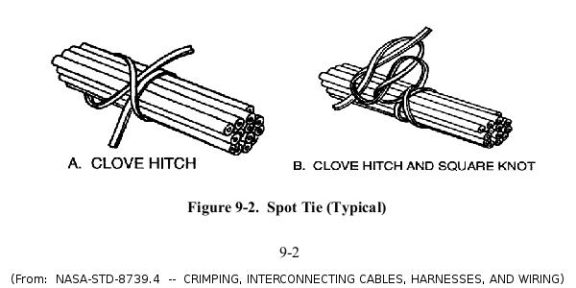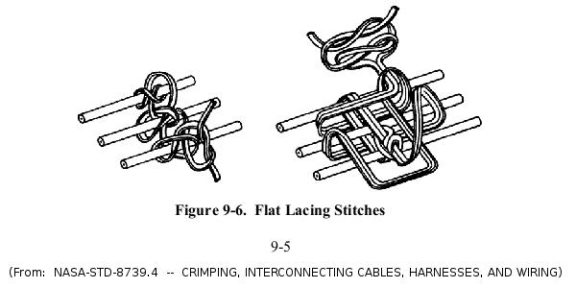David J. Fred • Sep 05, 2012
Knots on Mars
Editor's note: much of the content of this post originally appeared at the International Guild of Knot Tyers forum. It was brought to my attention when I mentioned my surprise at seeing knots on the cable bundles on Curiosity's self-portrait shots. I asked the author for permission to repost it here, and he kindly provided me with this edited version. --Emily Lakdawalla
Late last month Curiosity returned to Earth some of the first high resolution color images of its deck. These included some of the best images yet showing the knots visible on the exposed wire and cable bundles.
It might surprise most people to learn that multitudes of knots tied in cords and thin ribbons have probably traveled on every interplanetary mission ever flown. If human civilization ends tomorrow, interplanetary landers, orbiters, and deep space probes will preserve evidence of both the oldest and newest of human technologies for thousands, if not millions of years.
Knots are still used in this high-tech arena because cable lacing has long been the preferred cable management technique in aerospace applications. That it remains so to this day is a testament to the effectiveness of properly chosen knots tied by skilled craftspeople. It also no doubt has a bit to do with the conservative nature of aerospace design and engineering practices. Proven technologies are rarely cast aside unless they no longer fulfill requirements or there is something substantially better available.
While the knots used for cable lacing in general can be quite varied, in some cases even a bit idiosyncratic, NASA has in-house standards for the knots and methods used on their spacecraft. These are specified in NASA Technical Standard NASA-STD-8739.4 -- Crimping, Interconnecting Cables, Harnesses, and Wiring. As far as I've been able to identify in the rover images below, all of the lacings shown are one of two of the several styles specified in the standard.
The above illustration shows the so-called "Spot Tie" and represents the vast majority of knots shown in the rover deck images. It is a Clove hitch topped by two Overhand knots (half-knots) in the form of a Reef (Square) knot. In addition to its pure binding role, it is also used to affix cable bundles to tie-down points, as can be seen in the images below.
Serious knot history buffs may know that a "Spot Tie"-like knot, with opposite Clove hitch end orientation and topped only with a single overhand knot, was illustrated in 1917 by A. Hyatt Verrill under the name "Gunner's Knot". This was seemingly due to Verrill copying from J.T. Burgess, who had oversimplified "Bowling's" description of what possibly was the first known textual description of the Constrictor knot. But that's a whole different can of worms!
I find it quite interesting that yet another hitch knot (not a Clove nor a Gunner's) topped with a single overhand knot was recommended for cable lacing in both a 1905 Popular Mechanics article entitled "Cable Sewing Knots", and also two 1907 Telephony magazine articles: (Part 1, Feb 1907) and (Part 2, Mar 1907). The frequent use of the Double Strap Hitch (ABOK #1695) and also an unusual usage of the reef knot as a stopper knot for a tensioned doubled cord are both shown in the Telephony articles. Some of these specific patterns can still be seen in the NASA specification, as well those of the Australian Civil Aviation Safety Authority. Telephone companies also still use knots related to those used by linemen more than 100 years before, such as seen in this 2007 Qwest Corporation document, pp. 5-19 - 5-24.
All of these references, both old and new, share patterns of knot usage that are not often seen in general knotting literature. This seems to provide evidence that cable lacing knots have evolved somewhat independently, in isolation from other knot tying traditions.
So, that's some of the history, but what about the knots on Curiosity? Why might NASA have standardized on this particular knot, the Spot Tie, to use so extensively instead of the many others which might serve the purpose? The following reasons are merely my own musings:
The Reef knot and Clove Hitch are extremely ancient. Both were discussed in detail as surgical and orthopedic knots and slings by Greek physician Heraklas in the 1st century AD. The Reef knot is depicted with varying degrees of realism in ancient Egyptian statuary and hieroglyphics as far back as 4000-5000 years ago. I presume there would be little disagreement from knot experts that these two must be among the oldest of the purposeful, standardized knots used by humans. You simply cannot get more field-tested than this!
But why combine these two well-known old knots in a somewhat novel way that, without consideration, might seem a bit "belt-and-suspenders". Why not simply use a single more aggressive binding knot?
The inner profile of the clove hitch is smooth. Both turns bear on the bound object evenly throughout their contact. The contact area is increased by having two turns. When the Reef knot is added, the ends are pulled up and away from the object. There is some extra pressure exerted by the reef knot on the riding turn, but this is distributed onto the two underlying turns. Evenness of pressure is important for the same reasons as the next item.
Overtightening of cable management bindings can cause conductor breakage, insulation damage, excessive chafing, and deformations between the conductive, dielectric, and shield parts of a cable, and no doubt a host of other issues. It is one of the classic problems with ratcheting plastic cable ties (i.e. "zipties") that they only have quantized adjustment steps and cannot be easily loosened. While zipties with a metal tooth insert do allow for smoother tightening, the possibility of this tiny metal part coming loose near electronics generally excludes their use. Zipties cannot easily be loosened or adjusted after tightening and they may not conform to the cable bundle as well as lacing cord or tape. Difficulty of adjustment might also be considered a possible strike against using the Constrictor Knot (and similar knots) for this application.
The Clove hitch is not known as a particularly good binder alone, but that may be an advantage in this application. If the hitch is initially made too tight it is easily loosened and readjusted. Once the proper snugness is achieved the addition of the first overhand produces only a small and predictable amount of additional tightening. One thing I did notice in my tests is that if the first Overhand knot is made in the opposite orientation than shown in the standard, it tends to produce more tightening and also separates the underlying turns of the Clove hitch.
As discussed below, I performed some tests tying the knot incorrectly in different ways. While these forms generally seemed inferior to the specified knot, they were not obviously destined to fail. Using these two basic knots in a compound form seems to be a reasonable way to make errors of tying less detrimental to the resulting knot.
Here is a high resolution photo taken of these Spot Ties made in Nomex lacing tape. These types of aerospace lacing tapes are often coated or impregnated with materials (e.g. synthetic rubbers) to increase their knot-holding properties. I'm not sure what the tapes visible on the rover are made of, but I'd suspect the material was chosen for its behavior at extremely low temperatures and pressures as well as very good UV resistance. Outgassing is also probably a concern, especially inside the rover and/or near the scientific payload.
The keen observer may note that some of the Spot Ties in the rover images show the ends perpendicular to the cable bundle and some parallel. Based on general experience with Reef and Granny knots, one might be tempted to assume the parallel examples are improperly finished with Granny knots. Experimentation with Nomex lacing tape seems to show that it is more a matter of the knot preserving the orientation of the ends as the Overhand knot, Reef or Granny, was tightened. I found that when the Spot Tie is finished improperly in the Granny form but with the ends kept perpendicular to the wire bundle they tend to stay that way. While these experiments are hardly definitive, it doesn't seem to me that one can tell from orientation of the ends whether the knot was properly tied or not.
There is also the issue of the handedness of the first Overhand knot with respect the ends emerging from the Clove hitch portion. The relative orientation shown in the NASA spec does appear to be preferable to the alternative.
Another type of knots used in cable lacing is "flat stitches." Note that the right-hand figure begins with a Double Strap Hitch and finishes with the Reef knot as a tensioned stopper. These are both relatively unusual in general knotting, but found comparatively frequently in cable lacing references.
I won't go into much discussion about these "flat stitches", but I believe the lacing in the left-hand figure may appear on the extreme right edge of this image:
I hope this brief overview and discussion of the knots on Curiosity gives readers a sense of both how long humans have been using knots and also how valuable knowledge of them still is to our species. Although they have been replaced in many cases by Velcro, zipties, and other modern fasteners, they continue to have an important role to play in human endeavors, from climbing mountains, to exploring caves, rigging a sailboat, or even sending spacecraft to distant planets.
It is my firm belief that, as old as knots are, much more still remains to be discovered about this ancient technology.
Support our core enterprises
Your support powers our mission to explore worlds, find life, and defend Earth. You make all the difference when you make a gift. Give today!
Donate

 Explore Worlds
Explore Worlds Find Life
Find Life Defend Earth
Defend Earth







